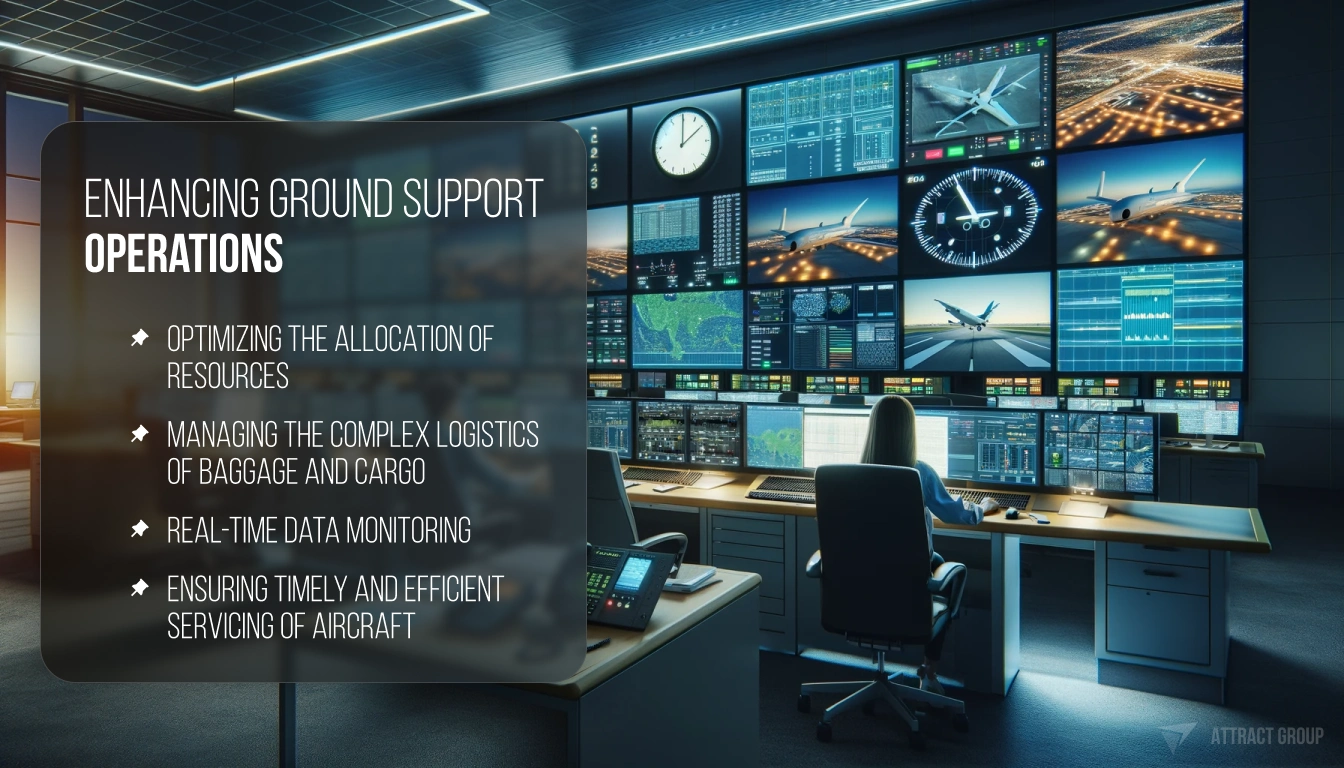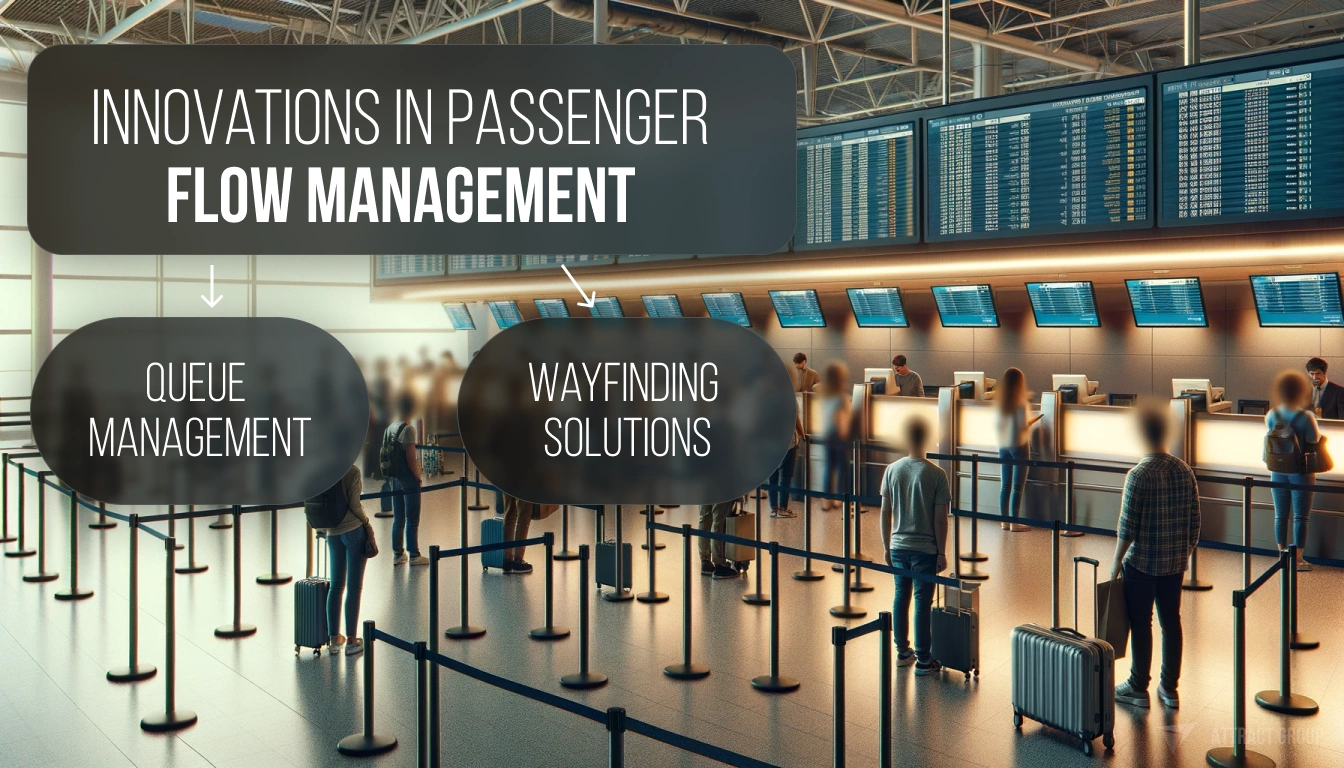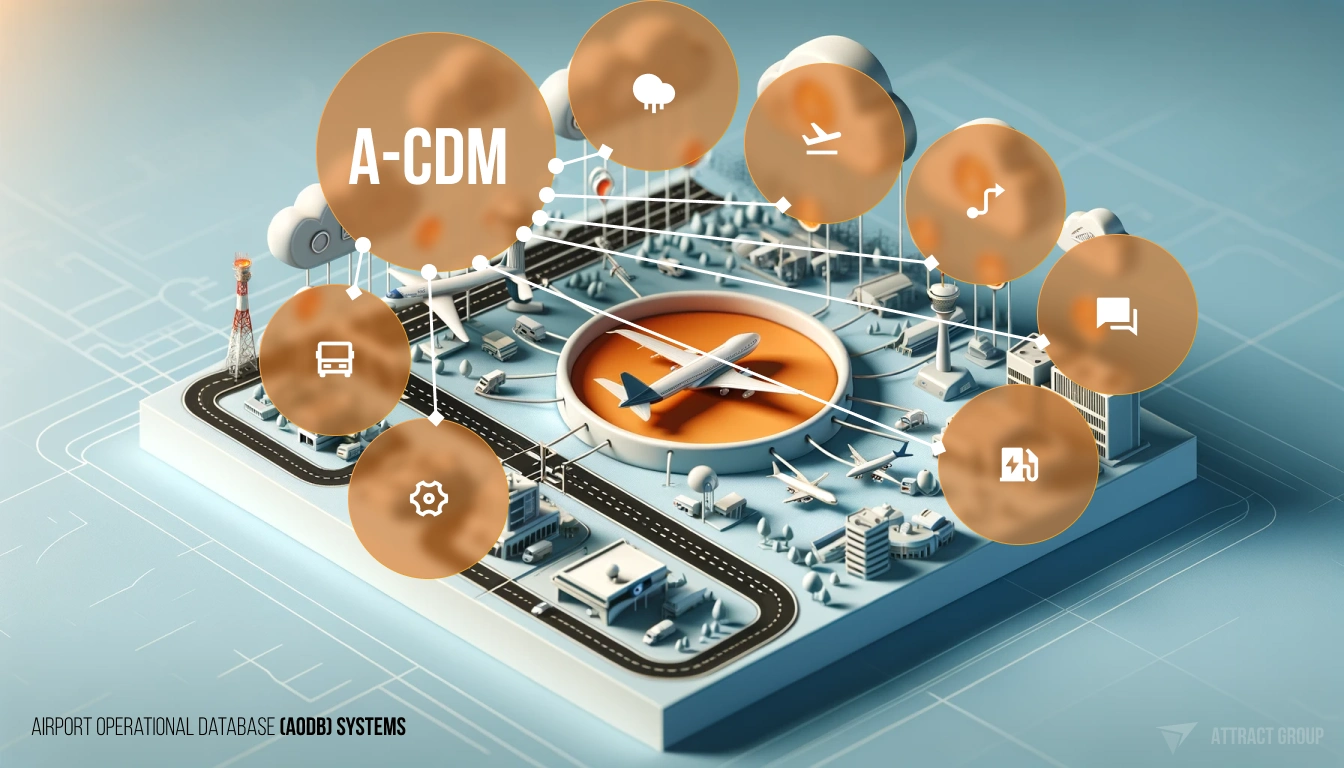A Guide to Creating Operations Management Software for Airports (AOCC)
 14 November 2023
14 November 2023Airports, the epicenters of global travel, require efficient Operations Management to ensure seamless functionality. This article delves into the pivotal role of advanced software in Operations Management in Airports.
From Airport Operations Control Center Software to Real-Time Airport Monitoring, these digital solutions are indispensable in optimizing Airport Logistics, managing Passenger Flow, and ensuring efficient Baggage Handling. We’ll explore how incorporating Ground Handling Management Software, Aircraft Turnaround Software, and Airport Staffing Software significantly elevates operational efficiency.
Additionally, we’ll examine the impact of Real-Time Data Solutions and Predictive Analytics in streamlining airport capacity management and decision-making processes, setting new standards in airport operations and passenger service quality.
Exploring the Need of Software for Operations Management in Airports
The seamless functionality of an airport, a hub of relentless activity and precision, hinges significantly on effective operations management. Airports, being critical transit points for millions of passengers and thousands of flights daily, demand an intricate orchestration of various elements—ranging from passenger flow, baggage handling, aircraft turnaround, to air traffic control. In this high-stakes environment, Operations Management in Airports plays a pivotal role.
The Crucial Role of Operations Management in Airports
Operations management in airports is a multifaceted discipline that ensures all airport operations, including airside and landside functions, run smoothly and efficiently. The introduction of specialized software in this domain has revolutionized the way airports operate. Airport operations control center software, ground handling management systems, and real-time data solutions are not just buzzwords; they are essential tools that drive efficiency and service quality in today’s airports.
Enhancing Efficiency and Service Quality
The deployment of operations management software in airports leads to significant improvements in efficiency and service quality. This software streamlines processes, reduces the scope for errors, and provides real-time insights for better decision-making. From managing airport logistics optimization to ensuring effective passenger flow management, these digital solutions are indispensable for modern airports.
Digital Transformation in Airport Operations
The impact of digital transformation in airport operations cannot be overstated. The integration of technology like real-time airport monitoring and predictive analytics for airport management has enabled airports to not only manage their day-to-day operations more effectively but also to anticipate and prepare for future challenges.
To complement our exploration of the technological advancements in airport operations, watch the insightful video Digital Transformation of Airports:
Realizing the Vision of Streamlined Airports
By adopting advanced software solutions, airports are now able to manage complex operations, ranging from baggage handling system software to airport staffing software, with greater ease and precision. These technologies offer an unparalleled level of control and oversight, paving the way for a more streamlined and efficient operational model.

Understanding Operations Management in Airports
The intricate world of airport operations demands a meticulous and strategic approach. This is where operations management plays a crucial role, serving as the cornerstone of efficient and effective airport functionality.
Defining Operations Management in Airport Sector
Operations management in airports encompasses a wide array of activities – from overseeing flight arrivals and departures to managing the intricate dance of baggage handling and ensuring optimal utilization of airport resources. It’s about ensuring that each moving part of the airport’s ecosystem functions in harmony, from the tarmac to the terminal.
Significance of Operations Management
The significance of operations management in the airport sector cannot be understated. It is essential for maintaining the safety, security, and efficiency of airport operations. In an environment where delays or errors can have extensive ripple effects, effective operations management ensures a smooth, safe, and timely flow of both passengers and flights.
How Digitization Transforms Airport Efficiency
The advent of digital technology has brought about a transformative shift in how airports manage their operations. By leveraging tools like airport operational database (AODB) systems and airport performance metrics software, airports can now manage their operations more effectively and proactively.

Integrating Technology for Enhanced Operations
Digital solutions such as real-time data solutions for airports and predictive analytics for airport management enable airports to not only react swiftly to real-time situations but also to anticipate potential issues and plan accordingly. This integration of technology enhances operational efficiency, passenger satisfaction, and overall airport performance.
The Airport Operations Control Center (AOCC)
At the heart of airport operations management lies the Airport Operations Control Center (AOCC), a critical component that ensures the smooth functioning of airport activities day in and day out.
The Nerve Center of Airport Operations
The AOCC serves as the command center for all airport operations, orchestrating various aspects such as air traffic, fuel, ground handling, and passenger services. It’s a hub where decisions are made, and information is exchanged to keep the airport running efficiently and safely.
Role of AOCC Software
In this nerve center, AOCC software plays a pivotal role. It integrates various systems and data points, providing a unified view of all operations. This software is essential for real-time airport monitoring, offering a dashboard of operations that helps in quick decision-making and effective management of resources.
How AOCC Software Contributes to Real-Time Airport Monitoring
Real-time monitoring is a critical aspect of airport operations, and AOCC software is at the forefront of this function. It enables the airport staff to have a bird’s-eye view of all ongoing activities, from runway traffic to terminal operations, ensuring that any issues can be quickly identified and addressed.

Advantages of Real-Time Monitoring
With features like real-time data solutions and predictive analytics, AOCC software allows airports to enhance their operational responsiveness. This not only improves the efficiency of the airport but also significantly enhances passenger experience by minimizing delays and ensuring smoother transitions.
Building Ground Handling Management Software
Ground handling is a vital component of airport operations, encompassing everything from baggage handling to aircraft servicing. The development of specialized ground handling management software marks a significant leap in optimizing these crucial operations.
Key Features and Functions of Effective Ground Handling Management Systems
Effective ground handling management software is characterized by a suite of features designed to enhance efficiency and accuracy. These features include real-time tracking of baggage and equipment, scheduling tools for staff and resources, and communication systems that link various ground support teams.
Enhancing Ground Support Operations
The key to effective ground handling lies in the software’s ability to streamline operations. This includes optimizing the allocation of resources, managing the complex logistics of baggage and cargo, and ensuring timely and efficient servicing of aircraft. By automating these processes, the software significantly reduces the likelihood of errors and delays.

The Role of Software in Optimizing Airport Logistics and Ground Support
In the fast-paced environment of an airport, every second counts, especially when it comes to ground support operations. Here, ground handling management software plays a pivotal role.
Streamlining Airport Logistics
The software provides a comprehensive platform for managing all aspects of ground operations. This includes real-time data on aircraft arrival and departure, which helps in efficient planning and execution of ground handling tasks. By ensuring that the right resources are at the right place at the right time, the software greatly enhances the overall efficiency of airport operations.
Real-Time Data Solutions for Airports
In the dynamic environment of airports, where situations can change rapidly, real-time data solutions have become indispensable for efficient and proactive operations management.
The Importance of Real-Time Data for Operational Decision-Making
Real-time data is a game-changer in airport operations. It provides immediate insights into various aspects of airport functioning – from passenger flow to aircraft movements. This information is crucial for making informed decisions quickly, significantly impacting everything from safety to customer satisfaction.
Facilitating Proactive Operations
Access to real-time data allows airport operators to anticipate problems before they escalate and respond swiftly to changing circumstances. Whether it’s adjusting to sudden weather changes or managing unexpected flight delays, real-time data i.e. arrival and departure times provides the necessary agility to maintain smooth operations.
How Real-Time Solutions Integrate with Existing Airport Infrastructure
Integrating real-time data solutions into existing airport infrastructure is a complex yet rewarding process. It involves the synchronization of various systems like flight information displays, baggage handling systems, and security protocols.
Seamless Integration for Enhanced Efficiency
The key to successful integration lies in ensuring that these solutions complement and enhance existing processes. For instance, real-time data can be used to optimize passenger flow management or streamline baggage handling processes, resulting in improved operational efficiency and a better experience for passengers and airlines alike.
Streamlining Passenger and Baggage Flow
Efficient management of passenger and baggage flow is a roadway for enhancing traveler satisfaction and airport efficiency. Innovations in software development have made significant strides in improving these aspects of airport operations.
Innovations in Passenger Flow Management

Innovating in passenger flow management involves implementing systems that can effectively manage and guide the movement of passengers through the airport. These systems utilize real-time data to anticipate bottlenecks, manage queues, and ensure a smooth transit for passengers through various airport checkpoints.
- Queue Management: Utilizing real-time data to adjust staffing levels and open or close lines as needed.
- Wayfinding Solutions: Providing digital signage and mobile app guidance to assist passengers in navigating the airport efficiently.
Enhancing the Traveler Experience
These technological advancements not only streamline operations but also significantly enhance the passenger experience. By reducing wait times and improving the flow through terminals, airports can ensure a more pleasant and stress-free journey for travelers.
Baggage Handling System Software: Improving Accuracy and Reliability
Baggage handling is another critical area where software can have a transformative impact. Advanced baggage handling system software ensures that luggage is processed, sorted, and delivered efficiently and accurately.
Key Aspects of Baggage Handling Software
- Automated Sorting: Improving the speed and accuracy of baggage sorting.
- Tracking Systems: Enabling passengers to track their baggage in real-time, providing peace of mind and reducing lost luggage incidents.
Aircraft Turnaround and Airport Capacity Management
Efficient aircraft turnaround and effective airport capacity management are essential for maintaining the flow of air traffic and minimizing delays.
Software Solutions for Efficient Aircraft Turnaround
Software solutions designed for aircraft turnaround focus on optimizing the various processes involved in preparing an aircraft for its next flight. This includes managing the timing of refueling, cleaning, and luggage loading, ensuring that aircraft spend minimal time on the ground.
Improving Turnaround Time: A Statistical Perspective
According to a report by the International Air Transport Association (IATA), even minor improvements in aircraft turnaround time can significantly enhance overall airport capacity and reduce delays. The report highlights that a reduction of 10 minutes in turnaround time can lead to a substantial improvement in the on-time performance of flights.
Techniques in Managing Airport Capacity Through Software
- Demand Forecasting: Using predictive analytics to forecast passenger and flight volumes, allowing for better resource allocation.
- Resource Scheduling: Optimizing the use of gates, check-in counters, and baggage carousels to handle peak times efficiently.

Enhancing Airport Staffing with Digital Tools
The dynamic nature of airports requires a flexible and efficient approach to staffing. Digital tools are increasingly being utilized to manage the complex staffing needs of modern airports.
The Shift Towards Digital Airport Staffing Software
Digital staffing tools allow for more effective allocation of human resources, ensuring that staff members are deployed where they are most needed. This includes real-time adjustments based on flight schedules, passenger flow, and other operational variables.
Optimal Allocation and Flexibility
These tools provide the flexibility to quickly adjust staffing levels in response to unexpected changes, such as flight delays or cancellations, ensuring that the airport operates smoothly under various circumstances.
How Technology is Meeting the Dynamic Staffing Needs of Modern Airports
- Automated Scheduling: Reducing the time and effort required to create and manage staff schedules.
- Real-Time Adjustments: Allowing for quick redeployment of staff in response to operational needs.
Impact of Digital Staffing Tools on Airport Operations:
| Feature | Impact |
|---|---|
| Automated Scheduling | Reduced administrative overhead |
| Real-Time Adjustments | Enhanced operational responsiveness |
| Staff Analytics | Improved staffing efficiency |
Key Performance Indicators (KPIs) and Metrics
For any airport, monitoring and improving performance is essential. Key performance indicators (KPIs) play a crucial role in this aspect.
Identifying Key Performance Indicators for Airport Operations
Common KPIs for airport operations include on-time departures and arrivals, baggage handling accuracy, and passenger satisfaction levels. These indicators help in assessing the efficiency and effectiveness of various airport processes.
Utilizing Software to Track and Improve Airport Performance Metrics
Software tools designed for monitoring KPIs enable airports to track their performance in real-time and make data-driven decisions to enhance operational efficiency.
Common KPIs in Airport Operations:
| KPI | Description |
|---|---|
| On-time Departures | Percentage of flights departing on schedule |
| Baggage Handling Accuracy | Rate of correctly handled baggage |
| Passenger Satisfaction | Levels of safety and security based on surveys |
Collaborative Decision-Making (CDM) in Airports
Collaborative Decision-Making (CDM) is a joint approach to managing airport operations, involving various stakeholders like airlines, ground services, and air traffic control.
The Process and Benefits of CDM in Airport Operations
CDM involves sharing information and coordinating actions among all parties involved in airfield operations. This collaboration leads to more informed decisions, resulting in improved efficiency and reduced delays.
Tools that Facilitate CDM among Airport Stakeholders
Advanced software tools enable effective CDM by providing a platform for information exchange and joint decision-making. These tools ensure that all stakeholders have access to the same real-time data, leading to more cohesive and efficient operations.

Airport Operational Database (AODB) Systems
The AODB system is the backbone of airport information management, integrating data from various sources to provide a comprehensive view of airport operations.
The Backbone of Airport Information Management
AODB systems collect and disseminate information related to flights, passengers, baggage, and other operational aspects. This centralized database is essential for effective airport management and operations as well as coordination of airport activities.
Integrating AODB Systems for Comprehensive Operations Management
The integration of AODB systems allows for the seamless flow of information across various airport departments, enhancing overall operational efficiency and decision-making processes.
Predictive Analytics in Airport Management
Leveraging predictive analytics in airport management enables proactive planning and decision-making, significantly enhancing operational efficiency.
Leveraging Predictive Analytics for Strategic Airport Management
Predictive analytics uses historical data and statistical algorithms to forecast future events. In airports, this can relate to predicting passenger flow, baggage volumes, or potential operational disruptions.
Case Studies: The Successful Implementation of Predictive Analytics Software
Several airports have successfully implemented predictive analytics software to improve their operations. For instance, Singapore Changi Airport has utilized predictive analytics to manage passenger flow and resource allocation effectively, leading to enhanced operational efficiency and passenger satisfaction.
Achieving Agility with Airport Operations Software
In an industry where conditions can change rapidly, agility in responding to operational challenges is key. Airport operations software plays a crucial role in enabling this agility.
How Software Supports Agile Responses to Operational Challenges
Airport operations software provides the tools and data necessary to quickly adapt to changing conditions. This could involve reallocating resources in response to flight delays, managing disruptions due to weather, or adjusting to fluctuating passenger volumes.
The Future of Airport Operations: Trends and Technological Advancements
The future of airport operations and management is likely to see continued technological advancements, with an increased focus on AI and automation. These technologies will further enhance the agility and efficiency of airport operations, leading to even better passenger experiences and operational outcomes.

Conclusion
The transformational potential of operations management in airports software is immense. By streamlining various aspects of airport operations, from passenger and baggage flow to resource allocation and collaborative decision-making, this technology plays a pivotal role in enhancing efficiency, safety, and passenger satisfaction.
Next Steps for Airports Aiming to Streamline Operations Through Technology
For international airports looking to adopt or upgrade their operations management systems, the journey involves careful planning, the selection of the right technological solutions, and a commitment to continuous improvement.
What is the role of operations management in airport efficiency?
Operations management in airports plays a crucial role in streamlining all aspects of airport functionality, from air traffic coordination to passenger and baggage handling. It ensures seamless operations, optimizing the overall efficiency and safety of the airport
How does digital transformation impact airport management and operations?
Digital transformation in airport management introduces advanced software solutions for real-time monitoring, passenger flow management, and efficient resource allocation. It significantly enhances operational decision-making, leading to improved service quality for both airlines and passengers
What are the key aspects of effective airport operations management?
Key aspects of effective airport operations management include efficient baggage handling, streamlined passenger flow, proactive air traffic control, and robust security measures. Each aspect contributes to the smooth functioning of an airport and enhances passenger experience.
How can technology improve passenger flow in airports?
Technology improves passenger flow in airports by utilizing data analytics for crowd management, implementing digital signage for wayfinding, and deploying automated systems for check-in and security, thereby reducing wait times and improving the overall travel experience.










